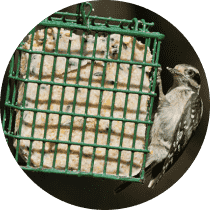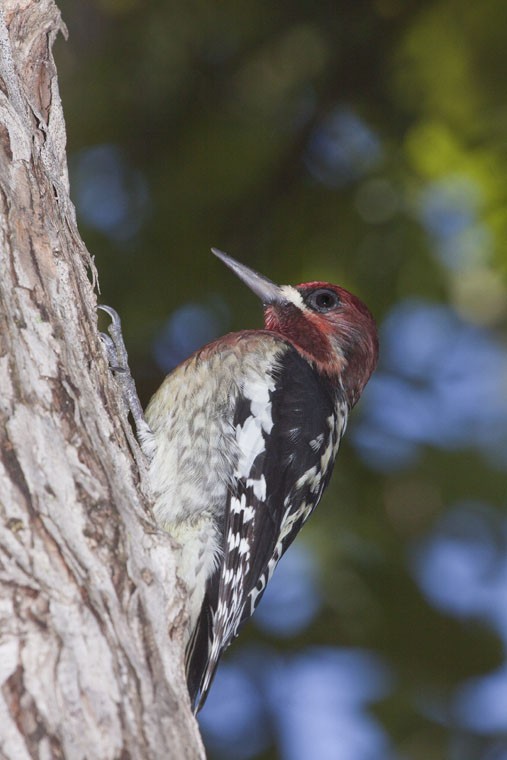Red-breasted Sapsucker
A species of Sapsuckers Scientific name : Sphyrapicus ruber Genus : Sapsuckers
Red-breasted Sapsucker, A species of Sapsuckers
Botanical name: Sphyrapicus ruber
Genus: Sapsuckers
Description
Adults have a red head and upper chest; they have a white lower belly and rump. They are black on the back and wings with bars; they have a large white wing patch. Red-breasted sapsuckers nest in tree cavities. Northern birds migrate to the southern parts of the range; birds on the coast are often permanent residents. Like other sapsuckers, these birds drill holes in trees and eat the sap as well as insects attracted to it. They sometimes catch insects in flight; they also eat seeds and berries. These birds interbreed with the red-naped sapsucker or yellow-bellied sapsucker where their ranges overlap. 
Size
20-23 cm (8-9 in)
Colors
Black
Red
Gray
Life Expectancy
4.8 years
Nest Placement
Cavity
Clutch Size
4 - 7 eggs
Incubation Period
1 brood
Number of Broods
14 - 15 days
Nestling Period
23 - 28 days
Feeding Habits
Red-breasted Sapsucker's diet consists of sap, insects, fruit, and seeds. Red-breasted Sapsucker has a specialized brushy-tipped tongue for lapping sap from drilled holes in trees. Insects are picked from bark crevices or caught midair. Red-breasted Sapsucker regularly revisits the same trees for sap, which may harm the tree but also attracts other insects for feeding.
Habitat
Red-breasted Sapsucker are typically found in forested habitats from southeast Alaska through the Pacific Coast Ranges to northern California. They prefer elevations up to 8,700 feet and are common in coniferous forests, particularly those with pine and hemlock. Red-breasted Sapsucker inhabit both old-growth and second-growth woodlands, and can also be found in orchards and along powerline rights-of-way. Seasonally, they migrate to coastal areas, adapting to a broader range of woodlands, including various deciduous and coniferous trees.
Nest Behavior
Red-breasted Sapsucker engage in nest building within chosen trees, laying eggs on a wood chip bed. After egg-laying, both parents partake in the care of eggs and young.
Nest Characteristics
Red-breasted Sapsucker's nest is a cavity about 2 inches wide at the entrance and roughly 10 inches deep, excavated in dead trees or dead parts of live trees like hemlocks and pines, lined with wood chips.
Dite type
Insectivorous
People often ask
Migration Overview
The northern birds that breed in migrate south in the winter, and individuals that breed in inland and upland locales often move to the coastal lowlands in winter, where the weather is milder. Winter habitat can be deciduous or coniferous woodland. This species’ winter range extends south to Baja California in Mexico. 
General Info
Feeding Habits
Bird food type
Bird Feeder Type

Suet Cage
Behavior
Red-breasted Sapsucker exhibit distinct climbing behaviors, moving vertically and laterally along tree trunks and limbs, as well as fences, using their powerful beaks and claws. They exhibit a characteristic undulating flight pattern. Their most unique behavior is the creation of sap wells in tree bark, a feeding strategy involving drilling shallow holes and consuming the exuded sap with their specialized tongues. Both genders display territoriality, fiercely defending these sap wells against intruders with various aggressive displays and vocalizations. During the early spring, their behavior includes elaborate courtship rituals, often re-establishing pair bonds that may persist across breeding seasons, indicative of site fidelity rather than partner attachment. Nest construction is solely handled by males who diligently excavate fresh cavities annually, with both parents actively participating in egg incubation, brooding, and feeding of the young.
Distribution Area
Red-breasted sapsuckers breed from southeast Alaska and British Columbia south through the Pacific Coast Ranges of western Washington and Oregon and northern California. The breeding habitat is usually forest that includes pine, hemlock, Douglas-fir, fir, and spruce, though they are known to use other woodland habitats. 
Species Status
Not globally threatened.
